|
I woke up this
morning to a pleasant "spring rain," which, in Antarctica, of course
means ridiculously cold winds and blowing snow. I made my way,
laptop over shoulder, big orange bag of ECW gear in hand, and clad in
gigantic red parka over to Highway 1 in building 155 to find that a
condition 2 had been called at Willy Field. We agreed to meet in
the lounge of 203A (the dorm where I'm staying) after breakfast.
Dave told us there that we were not going to risk driving our vans out
to Williams Field, and that we would be taking the terrabus
instead.
Now the terrabus, or "Ivan,
the Terrabus" is a fantastic all-terrain monster truck that is normally
used to bring large groups
|

|
|
from the Ice Runway to McMurdo, but since we
were such a large group, we were able to nab it for today. Once
out at Willy, however, the weather wasn't as bad as it was yesterday,
or so it seemed.
Now that Drew and his crew have finished
mounting the SIP and other related electronics, we were able to cover
TIGER up and get it up and running again. The photomultiplier
tubes on the TIGER payload are extremely sensitive to light. When
they are run at high voltages, it is imperative that they be in an
entirely light-tight environment, since bright lights can completely
destroy the photocathode and ruin a PMT. And each of TIGER's 192
PMTs costs a few thousand dollars! So, TIGER ran for a couple of
hours and was able to see three whoppers, which means that the
instrument is working as it should.
The closer it gets to launch time, the more intense
things get around here. The whole balloon campaign experience is
very interesting. I've only really been on two campaigns in my
relatively short scientific career so far, but it seems like no matter
how many that you're a part of, it's never clear how things will
go. This year, since there are two experiments down here both
working to get the first flight opportunity, it makes things even more
exciting. Getting the first launch down here is pretty important
for the success of the mission. The earlier that you launch, the
more likely it is that the balloon will have enough time to complete
more than one orbit around the continent before things begin to shut
down at McMurdo for the season. Furthermore, recovering the
payload is vital for most astrophysics experiments down here, since
these missions are relatively low-budget (the entire TIGER payload is
estimated at just over a million dollars) and are most often created
from the resources of only a few universities and institutions.
The situation this year is particularly fun on our
end mainly because of the logistics of getting two very different
experiments (TIGER and ANITA) together and operational on the same
payload with the same data system and telemetry equipment. On the
other end, things are tense because the TRACER balloon campaign has
been delayed for about three years and they are very anxious to get a
long balloon flight. In fact, TIGER and TRACER were both
scheduled for launches from Alaska this past summer, but foreign policy
issues eventually put a stop to that: securing an agreement with
Russia for a flyover proved to be more difficult than was previously
supposed. And to top it all off, TIGER's
last flight in 2001 - 2002 was so successful, that it almost seems
fair that TRACER get the glory this time around. Well, almost!
|




